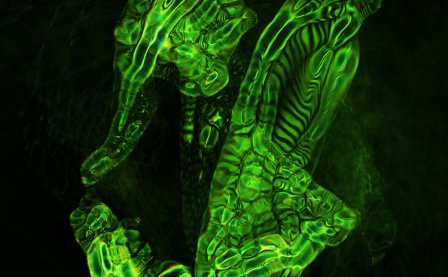What is a mix’s function? It seems related to, but different from an album, operating according to similar principles of coherence, but diverging from the former’s dependence on singular expression — the need for the album to stand as a body of work issued from one place only. The form of authority instantiated by the mix is more diffuse — looser — than that of the album; a mix can show its seams. In fact, this seems part of its appeal, its authorial weight emerging through the transparent production of a total soundworld, with tracklist in tow. With a mix, we become privy to the real-time arrangement of the constellation of sounds, aesthetics, and affects that make up an artist’s world, so that we might note the shapes, the centers of gravity, the warps and wefts that predominate. Which brings us to Fabriclive 100.
Kode9 and Burial’s mix functions as a exploration of the sounds of the hardcore continuum and as a charting of those contemporary global club musics whose only shared principle seems to be their digitized transmission. It’s pulled together by bass weight, arrayed around splintered forms, its multiplicitous histories and geographies shimmering into view atop the fading crackle of vinyl and the click-n-clunk of changing tapes. Within this nexus of sound, competing versions of the contemporary move with and through each other: for the valence of our current moment defined by disconnection and velocity, we have Klein’s fractured poetics, the brittleness of footwork, and the jagged harshness of Lechuga Zafiro. For the hauntological present — that mode of the contemporary defined by the slow cancellation of the future and the reproduction/repetition of the past — we have the ghosts of frayed jungle, washed-out rave, and malevolent acid.
These multiple histories and geographies mingle together, and Kode9 and Burial switch between them laterally, shunting a sound to the side just as another is phased in, an approach that imbues the mix with an odd sense of time and place, as hyperspecific geographies — Chicago, Durban, London — mesh with an eerie timelessness, a sense that these musics have become unmoored, adrift, lost in fog and rain. The mix’s complex temporalities and particular geographies make the act of listening recursive, as one is made acutely aware of one’s own position in relation to this music.
Consequently, there’s a mournfulness to be found here, as the impassability/impossibility of the distance joining listener and track is foregrounded: how could one have been “there” at the site of this music’s inception, where “there” is an east London rave in the 90s or a taxi in Durban in 2014? The spaces and times from which this music emerges recede, lost to the wildness of the past, while the music itself persists, leaving us with its aesthetic signifiers and sonic forms: gqom’s plosive kicks and eerie atmospherics, jungle’s spectral ambiences, footwork’s brittle hi-hats. These are the traces of this music’s mediation, the histories of its transmission across time and space.
And these traces inevitably alight at death, mediation’s steadfast companion. DJ Rashad’s “Let It Go” serves as one of the mix’s anchor points, a track that after Rashad’s death is overcoded with feeling, indexing a past that has ended and a future that will never arrive. “Let It Go” arrives only to be overtaken by hiss and static, unable to play out in full, breaking down.
But this breakdown does not signal an end. Rather, it serves to lay the foundations for new and different beginnings, as Kode9 and Burial follow the mutation of sonic signifiers — the jungle break, the footwork clap — as they become attached to new styles, places, and affects. An architecture of mediated sound is being built here, flecked with the indelible traces of the locations, communities, and forms of feeling contained in the music. And, importantly, the process of this construction is suffused with joy, with the afterglow of countless nights remembered and forgotten. In the housing of these transmissions from parallel dimensions, in the tracing of these complex temporal webs, in the encasing of it all — these histories, these places, those lost (RIP Spaceape), those still with us — we remain, with and in the music. Hands in the air, hearts on our sleeves.




